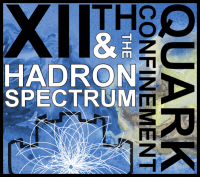Speaker
Description
We investigate the thermal-photon emission from strongly coupled gauge theories at finite temperature via the bottom-up models in holographic QCD in the deconfined phase. Particularly, we apply a model encoding flavor degrees of freedom in the Veneziano limit of a large number of colors $N_c$ and flavors $N_f$ but fixed $x=N_f=N_c$ (VQCD). In this model, the normalization and gauge-field couplings pertinent to photon production have been chosen to approximately reproduce the electric conductivity obtained from lattice simulations for the quark gluon plasma (QGP). The emission rates are then embedded in hydrodynamic simulations combined with prompt photons from hard scattering and the thermal photons from hadron gas to analyze the spectra and anisotropic flow of direct photons in RHIC and LHC. We compare the results for different sources responsible for the thermal photons in QGP including the weakly coupled QGP (wQGP) in the hard-thermal-loop approximation, strongly coupled $\mathcal{N}=4$ super Yang-Mills (SYM) plasma (as a benchmark for reference), and Gubser’s phenomenological model in holography. In general, the direct-photon spectra are enhanced in the strongly coupled scenario compared with the ones in the wQGP especially in high momenta. Moreover, by using IP-glassma initial states, both the elliptic flow and triangular flow of direct photons are amplified in high momenta for VQCD and the SYM plasma. We further compare our results with experimental observations.




